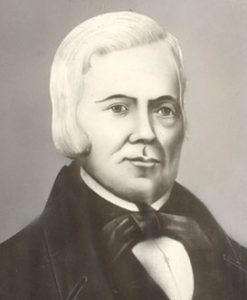
(Oct. 24, 1784-Mar. 28, 1842). Born near Danville, Kentucky, Holman was one of 14 children. His father died in 1789 while attempting to rescue his wife and children during an encounter with Native Americans. After teaching school for a time, tradition has it that Holman read law in Henry Clay’s office. Admitted to the Kentucky bar in 1805, he practiced the lawyer’s trade in New Castle, Port William, and Frankfort, Kentucky.
Holman married in 1810 and that same year published a novel, , which he later tried to find and destroy as he was convinced that the work was bad for young people’s morals. A year after his book’s publication, he and his wife moved to the Indiana Territory, settling near what is now Aurora. Holman built a house, which he named Veraestau (a combination of the Latin words for spring, summer, and fall), on a bluff overlooking the Ohio River. This handsome structure is listed in the National Register of Historic Places.
In 1816, after earlier service in the territorial legislature and judiciary, Holman became one of the first three Supreme Court justices for the new state of Indiana. He was reappointed in 1823, and two years later the court moved from Corydon to the new state capital.
With Governor James Brown Ray’s refusal to reappoint him to the court in 1830, Holman turned to other activities. He served on a committee selected to write the ‘s constitution, was ordained a Baptist minister, and helped found and Indiana College (now Indiana University). In 1835, President Andrew Jackson appointed Holman as judge of the United States district court for Indiana, which was located in Indianapolis. He held this post until his death.

Help improve this entry
Contribute information, offer corrections, suggest images.
You can also recommend new entries related to this topic.